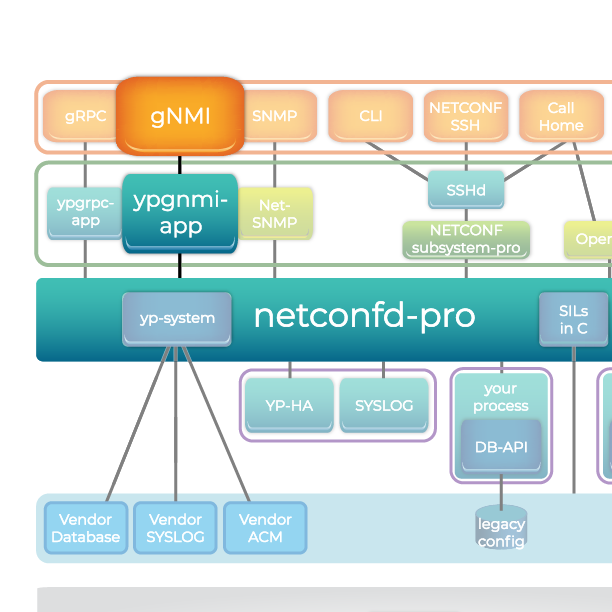
gNMI Introduction
YumaPro SDK Architectural Components

This document describes the gNMI (gRPC Network Management Interface) integration within the netconfd-pro server and ypgnmi-app application. The model-driven configuration and retrieval of operational data using the gNMI CAPABILITIES, GET, SET, and SUBSCRIBE gRPCs.
gNMI Features
The main gNMI service functionality contains the following requests:
Capabilities used by the client and target as an initial handshake to exchange capability information
Get used to retrieve snapshots of the data on the target by the client
Set used by the client to modify the state of the target
Subscribe used to control subscriptions to data on the target by the client
The ypgnmi-app application is capable of handling these requests and transferring them to the netconfd-pro server for further processing, as well as handle replies from the netconfd-pro server and transmit them back to the gNMI clients.
Introduction to YumaPro Telemetry
STREAM Feature sets a new benchmark for real-time network monitoring and management.
YumaPro provides a complete model-driven telemetry framework based on the gNMI protocol. Unlike legacy monitoring techniques such as SNMP polling or CLI scraping, YumaPro telemetry streams operational and configuration data directly from the YANG-based datastore in a structured and efficient manner.
Telemetry is "model-driven" because it leverages YANG data models to define what data is available, how it is structured, and how it can be retrieved or streamed. This ensures consistency, interoperability, and automation across a wide range of client applications and network devices.
YumaPro's telemetry solution is tightly integrated into the netconfd-pro server and ypgnmi-app application. The telemetry engine within ypgnmi-app application exposes standardized YANG-modeled data via gNMI, enabling real-time streaming, historical monitoring, and scalable network observability.
Model-Driven Telemetry in YumaPro
The YumaPro telemetry subsystem implements gNMI as defined by the OpenConfig initiative, providing a standards-based framework for streaming model-driven telemetry. By leveraging YANG-modeled data and efficient gRPC transport, YumaPro enables scalable, real-time monitoring and automation.
Key features include:
gNMI Subscriptions - Clients can subscribe to YANG-defined data using ONCE, POLL, or STREAM modes. This allows telemetry to be tailored to different operational use cases, such as periodic sampling or event-driven updates.
YANG Integration - All telemetry data is encoded according to the same YANG modules used for configuration and operational state, ensuring a single source of truth across NETCONF, RESTCONF, and gNMI.
gRPC Transport - Communication with clients is performed using the gRPC protocol, providing a secure, high-performance channel optimized for large-scale, high-frequency telemetry delivery.
Broad Client Compatibility - Because the YumaPro gNMI implementation (via ypgnmi-app) adheres to the standard gNMI specification, it is fully interoperable with widely used tools such as gnmic, gNXI Tools, gnmi_cli, and other OpenConfig-compatible clients.
By combining schema-driven data models with streaming telemetry delivery, YumaPro enables modern monitoring workflows aligned with industry standards.
OpenConfig Telemetry and YumaPro Integration
OpenConfig Telemetry is an industry initiative that defines gNMI as the primary protocol for telemetry and leverages vendor-neutral YANG models developed by the OpenConfig community.
YumaPro integrates with OpenConfig in the following ways:
Support for OpenConfig YANG Models - Users can load and enable OpenConfig YANG modules directly in netconfd-pro.
gNMI Protocol Compliance - YumaPro’s gNMI subsystem follows the OpenConfig gNMI specification, ensuring interoperability with common telemetry collectors (e.g., gnmic, Telegraf, InfluxDB, Prometheus, etc.).
Streaming Telemetry Workflows - Operators can set up subscriptions using OpenConfig-compliant paths and receive structured updates over gNMI without additional configuration steps.
Unified Management - OpenConfig telemetry works side-by-side with other YANG modules (IETF, vendor-specific, or custom), providing flexibility while maintaining standards compliance.
This means YumaPro deployments can seamlessly integrate into OpenConfig-based monitoring ecosystems while still supporting all other YANG models required by the system.
gNMI Protocol Restrictions
The path specified in the request(s) MAY utilize wildcards. The Phase I of the gNMI protocol integration supports only fully-specified paths. The wildcards in Request(s) may be supported in the feature.